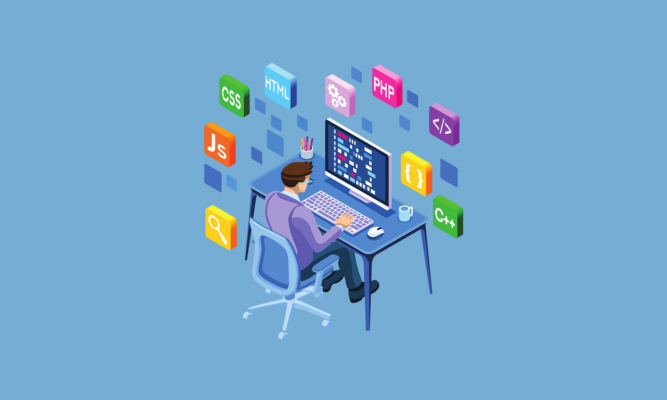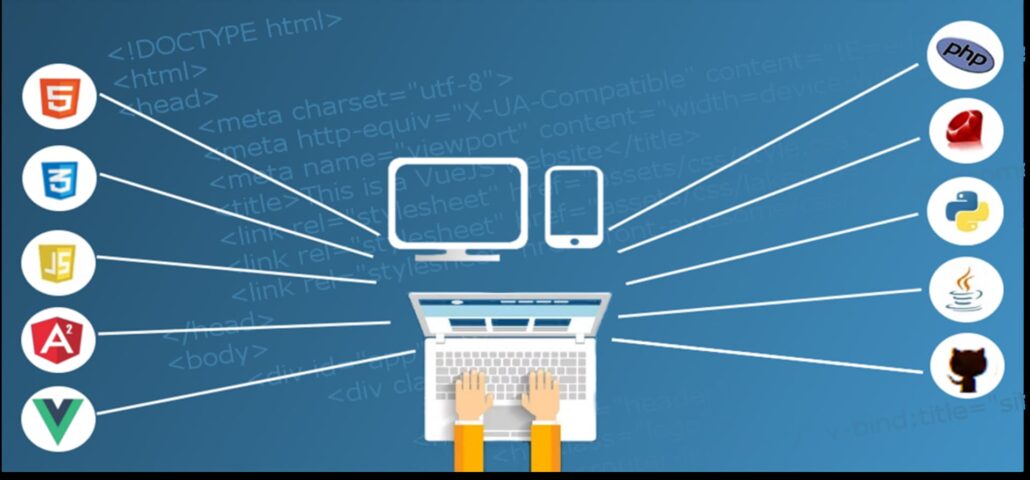
Let’s say you have a concept for a startup, or you wish to have a web application for your company. You have calculated your functionality with extreme care and have already pictured your brand-new app. You likely hired a contractor, determined the technical requirements, created prototypes, and approved the design.
Before Selecting a Technology Stack for Your Web Application
To begin, you need to have a solid understanding of the inner workings of your application to have productive communication with your programmers. In this context, it is essential to know that each web application has both a frontend and a backend.
The frontend, often known as the client-side, refers to everything that end consumers see when they look at their screens. The data are sent from the server to the frontend, where they are processed and shown to the user. In addition, this part of the application handles user actions and enables users to engage with the application interface.
The server-side of your application is referred to as the backend. This program section is responsible for storing all necessary data, and in response to the client application’s request, the data is then structured and processed.
Technologies for Frontend Development
The following is a list of the primary components that make up the frontend technology stack:
- HTML (Hypertext Markup Language). The structure of the information that is shown in the browser is defined by it.
- CSS (Cascading Style Sheets) is a language for style sheets used to specify the appearance and formatting of a page written in HTML.
- JavaScript is a programming language that can be executed inside the browser and turns a page into an interactive experience.
Technologies for Backend Development
A more significant number of components may be found in the backend part of the development stack. Here, you have much leeway. Users do not see the backend since it operates behind the scenes. On the other hand, it functions as the engine that drives the application and carries out the business logic.
The following are the primary components that are included in every backend technology stack:
The underlying operating system in which the programming is done.
A web server receiving requests from a browser and then sending back the data that corresponds to those requests
A database that stores all of the app’s data.
The programming language that was used in the creation of the app.
A web development framework that enables developers to occur more quickly and with less effort.
Programming Languages for Web App Development
Let’s look at the Popularity of Programming Language (PYPL) Index rating, derived from an investigation of the frequency with which language tutorials are searched on Google. When a language tutorials examined more, one may reasonably presume that this language is more widespread. Following that, let’s have a glance at a few of the most widely regarded languages, as ranked by the PYPL Index:
- Python
Python is now the most popular programming language, and its use has lately been growing exponentially. It may be used in various contexts, from websites to desktop applications. Python development is relatively fast and high-quality. - PHP
The backend developer community strongly supports the scripting language known as PHP. Scripting languages such as PHP are widely used in backend development. PHP is also used to develop various content management systems (CMSs). - JavaScript (Node.js)
Surprised? To answer your question, JavaScript is also employed on the backend. The V8 JavaScript engine that Chrome uses serves as the foundation for Node.js, which is a JavaScript runtime environment. Built on Chrome’s V8 JavaScript engine, Node.js acts as a JavaScript runtime environment. - Go
Google’s Go is a compiled, multithreaded programming language created by the company. “Go was designed to solve real-world problems that arise when developing software at Google,” said Rob Pike, quoted in an article. - Java
Java, much like Python, may be used in a diverse scope of applications. Java is a programming language that may be used to create mobile applications for Android, desktop programs, and backend servers. - Other Languages
Backend programming languages come in a wide variety, including C# (.NET Framework), Ruby (Ruby on Rails), and many more. Do not freak out if the members of your development team recommend a solution that is not on this list; instead, take the time to learn more about the offered language.

Databases
Following our discussion of programming languages, the next step is to determine the storage for all of the data. The Stack Overflow database ratings are shown in the following table.
Web Server
The web server’s job is to take HTTP requests from clients (such as web browsers and mobile apps), send those requests to the appropriate application, and then deliver the HTTP response to the client.
What Factors Should Be Considered When Selecting a Technology Stack
Various kinds of technological advancements are detailed up there. At this point, you may consider something like, “Okay, I see that there are various technologies, but which should I select for my project?”
Project Size and Complexity
Ready-made content management systems may be appropriate for more straightforward web applications, such as landing pages or minimum viable products (MVPs). If you go with an off-the-shelf solution that’s already been developed, you’ll save a lot of time and money on the development process. Nevertheless, you’ll sacrifice some flexibility and functionality.
Team in Charge of Development and Budget
Because it is always possible that you may need to recruit new staff or replace existing ones while working on a project, you must consider your technology stack carefully before you begin the development process.
Time to Market
We cannot stress enough how important it is that you not hurry the development process. However, suppose your deadline will play a significant part in the development of your project. In that case, you must ensure that your deadline is clear to the developers. In this way, they can choose an optimal technology stack that prioritizes the pace of development.
Stack of Technologies Used by Orangesoft
At Orangesoft, we have found what we believe to be the ideal tech stack for our projects, which brings together the most beneficial aspects of web application development. Our technology stack allows us to complete all of our activities successfully while maintaining a high level of development quality and efficiency.
On the front end, we use JavaScript and React.js, while on the back end, we use Symfony (PHP) and Node.js. We use MySQL, PostgreSQL, and MongoDB when it comes to databases.
You are always welcome to schedule a free consultation if you are unsure about the technology stack that you wish to utilize for your project. You just need to provide a description of your project and its technical specifications. Our experts will do the research and then provide you with a plan outlining the most effective options by which you can bring your idea into reality.